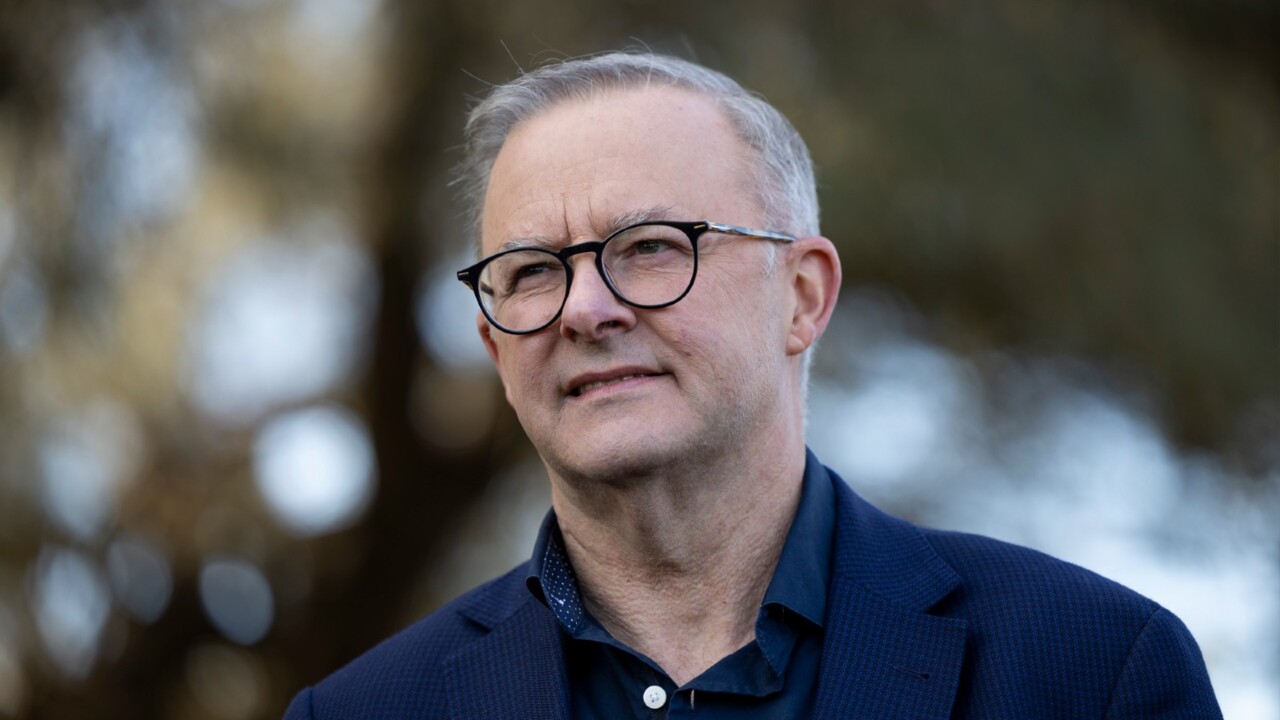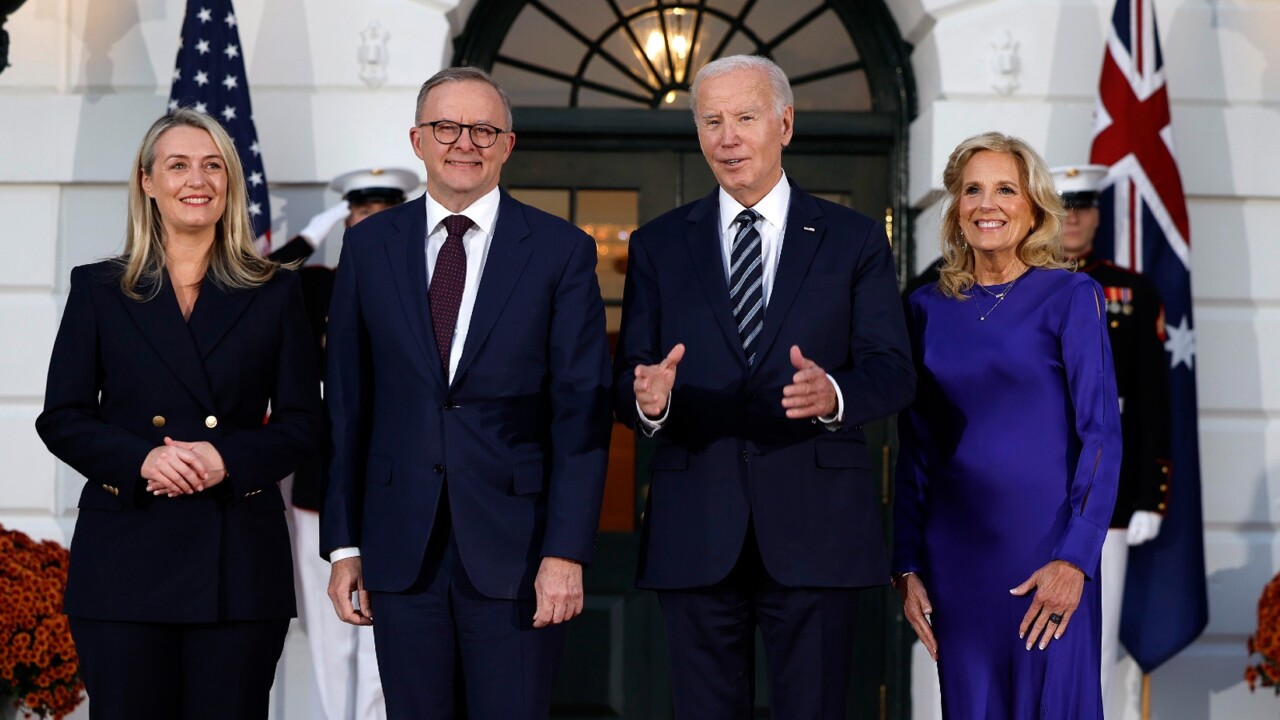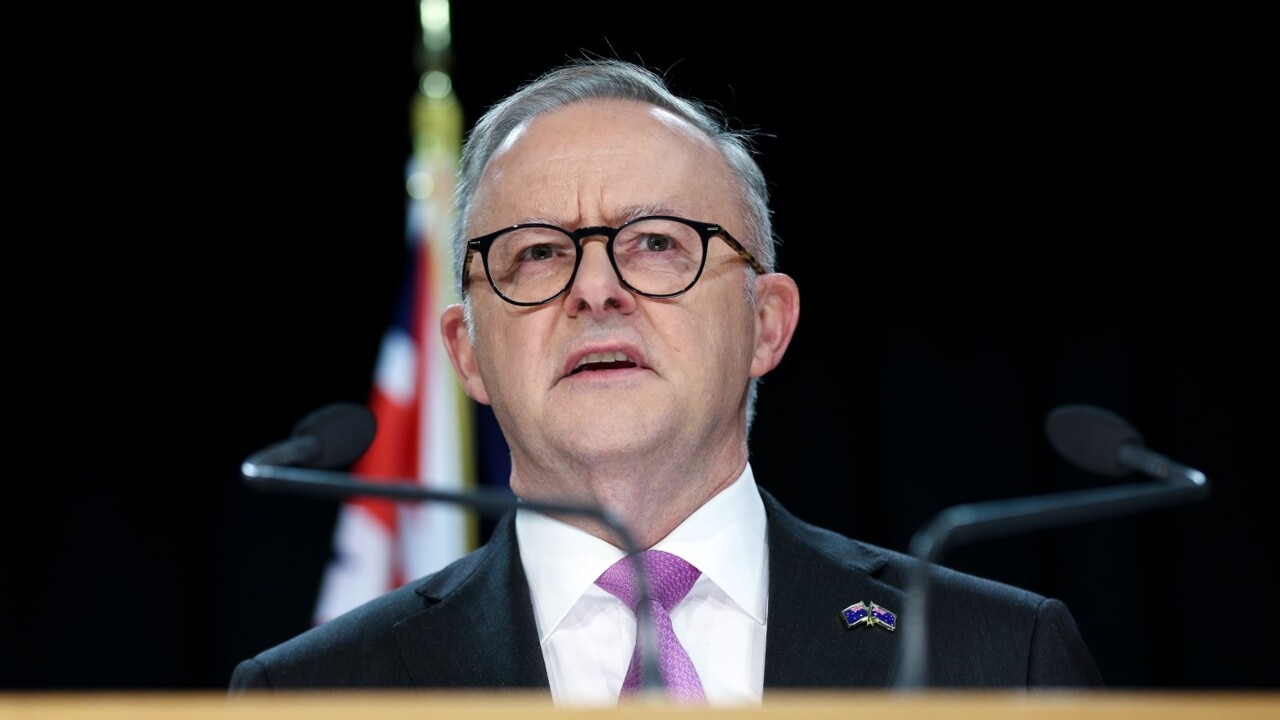The making of Anthony Albanese’s mid-term malaise
Anthony Albanese’s self-assurance contrasts with a growing number of Labor MPs and strategists who fear they will be lucky to form minority government when voters go to the polls in 2025.

Anthony Albanese’s self-assurance, or “hubris” as described by some colleagues, contrasts with a growing number of Labor MPs and strategists who fear they will be lucky to form minority government when voters deliver their verdict in 2025.
At the halfway point of his first-term in power, Albanese’s unshakeable optimism and belief that Peter Dutton is unelectable belies a myriad of economic, social, security and global pressure points starting to bite the government.
The 60-year-old, brimming with confidence after rubbing shoulders with the two most powerful men in the world, has no intention of giving up the keys to the Lodge anytime soon.
If he wins the next election, Albanese is expected to stay put for the full term, and potentially beyond. Those close to the Prime Minister say his view, shared by others in the party, is that right now there are no credible, mainstream leadership candidates to replace him.
Kevin Rudd had Julia Gillard nipping at his heels, Bob Hawke had Paul Keating knocking on the door. Albanese leads a timid caucus, dominated by individual personalities, inexperienced backbenchers and a fractured right-wing faction.
Ahead of his government’s 18-month anniversary on Tuesday, Albanese’s extended honeymoon has come to a crashing halt. The reversal in political fortunes has occurred at breakneck speed since the disastrous October 14 voice referendum.
He left behind a mess in Canberra on Wednesday when he flew to San Francisco to meet APEC leaders and chief executives controlling trillions of dollars. In the worst parliamentary week for the government since the election, Labor’s weaknesses and lack of political judgment were on show.

Albanese, who has never held a major economic or national security portfolio, was flat-footed as Dutton picked apart Labor’s calamitous handling of the High Court decision releasing high-risk immigration detainees and the government’s response to ugly scenes of anti-Semitism.
The left-wing warrior has been found wanting on his election promise to unite Australia and return transparency to politics. Tony Abbott made a similar pledge after his 2013 election victory, telling voters they could trust his government.
Trust between Labor governments, who earlier this year claimed a clean-sweep on the mainland after Chris Minns’ election victory, is also disintegrating. The Queensland and NSW governments this week launched scathing attacks on their federal colleagues after Infrastructure Minister Catherine King slashed funding for major projects, while the West Australian government expressed concerns over the release of 32 immigration detainees with criminal records.
Self belief
Albanese considers his 2022 post-pandemic election victory over the deeply unpopular Scott Morrison as a historic moment in the nation’s history. The Prime Minister and his coterie of loyalists believe Labor was swept into government by an adoring electorate that will vanquish the Coalition to the opposition benches for consecutive terms.
History will show that the Albanese government’s slim majority victory was won with a historically low 32.6 per cent primary vote, no major gains in Queensland and an unprecedented wave of support for the Greens and teal independents that decimated the Liberal Party.
While Albanese has successfully passed major legislation enabling his core election promises, Labor insiders, business leaders, economists and climate advocates believe the government’s mandate is diminished. Some say the government has fallen into a state of inertia, struggling to keep pace as global and domestic pressures pile up.

Labor’s marquee off-budget vehicles, including the $15bn National Reconstruction Fund, $10bn Housing Australia Future Fund and $20bn Rewiring the Nation Corporation, are unlikely to deliver tangible results by 2025.
The Indigenous voice referendum, Albanese’s passion project and first major legacy play, was emphatically rejected by more than 60 per cent of voters. Of particular concern for Labor strategists was the high No vote in the battleground states of Western Australia, Queensland, Tasmania and NSW. The disastrous result, stalling Labor’s Indigenous policy agenda and commitment to progress truth-telling and treaty, was blamed on Albanese and associated with concerns that the government had taken its eye off the cost-of-living crisis. Veteran Labor strategist Bruce Hawker said: “If I were Albanese and (Jim) Chalmers, I certainly wouldn’t be hitting the panic button yet.
“I’d be just making sure we get the basics right, that it is the ‘economy stupid’ and everything else will fade into the distance including residual angst about the voice. There are plenty of challenges ahead for the government but there are no signs of any great enthusiasm for Dutton.
“He is not capturing the imagination of the Australian public or successfully prosecuting the case for change.”
Voter blowback
As Albanese and Chalmers struggle to sell their $23bn, 10-point cost-of-living plan, Labor MPs are feeling increasingly vulnerable.
The Weekend Australian understands Labor seats considered to be at risk include Paterson, Gilmore, Richmond, Bennelong, Reid and Robertson in NSW, Swan, Pearce, Tangney and Hasluck in WA, Boothby in South Australia, Chisholm, Higgins, Aston and McEwen in Victoria and Lyons in Tasmania. Electoral redistributions in NSW, Victoria and WA are also being watched closely.
Hawker, a former key adviser to prime ministers and premiers including Rudd and Bob Carr, describes Chalmers as a top government “asset”. The government’s re-election campaign will kick into gear after Chalmers delivers his third budget in May.
“If the government looks sober with a treasurer who knows what they are talking about, even if you don’t agree with everything they say and do, but you get a sense that they understand what they are doing, that is a big plus. You’ve got that in Jim Chalmers,” he says.
Last year’s success in WA, which delivered Albanese majority government, is considered by state Labor operatives as the “high watermark”. The departure of premier Mark McGowan is viewed as a big blow. While state and federal politics typically cover different issues, federal Labor strategists concede McGowan’s X-factor turned votes.

The exit of former Victorian premier Daniel Andrews, another polarising pandemic-era leader, leaves federal Labor vulnerable in the southern state. Labor’s fortunes are also waning in Queensland, with three-time election winning Premier Annastacia Palaszczuk on track for a heavy defeat at next year’s state election.
There is also blowback against Labor’s faltering Powering Australia plan, with emissions-reduction targets in doubt, the rollout of renewables and transmission lines moving too slowly and an election promise to lower household power bills by $275 a year from 2025 in tatters. Chris Bowen has 73 months to cut emissions by 43 per cent and lift renewables to 82 per cent.
Labor’s big climate agenda, focused on electric vehicles, renewables and batteries, is stoking anger in regional electorates and target seats where voters are protesting against offshore wind farms and overhead transmission lines, and anxious about the rapid transition away from coal.
PM’s power team
Some Labor figures have sheeted blame for the referendum defeat on Albanese’s chief-of-staff, Tim Gartrell, a former ALP national secretary who spent decades campaigning for constitutional recognition for Indigenous Australians. Gartrell, who ran Albanese’s first Grayndler campaign in 1996, led the Yes side to victory in the marriage equality postal vote. But senior Yes23 campaigners say Gartrell and other senior strategists failed to comprehend that the voice model put forward by Albanese was an impossible proposition to sell to sceptical voters concerned about paying their mortgages and grocery bills.

Gartrell, considered one of Australia’s most successful modern campaigners, is Albanese’s closest adviser alongside Department of Prime Minister and Cabinet secretary Glyn Davis. Davis, a former University of Melbourne and Griffith University vice-chancellor who held senior Queensland public service roles under Wayne Goss and Peter Beattie in the 1990s, is tasked with Labor’s ambitious climate change, economic and social policy agenda. The 64-year-old is also leading cultural and structural changes across the Australian Public Service.
ALP national secretary Paul Erickson, a member of Albanese’s Left faction who is respected across the board, runs the organisational wing and provides Albanese with strategic advice and polling research.
There has been internal criticism of Albanese’s preference to surround himself with old friends from university and political circles, with some detractors concerned the Prime Minister is operating inside an echo chamber.
The Albo way
Since the voice referendum, Albanese has visited Washington, Beijing, Shanghai, Cook Islands and San Francisco over four separate trips. He was on a RAAF jet flying from China to the Cook Islands when the Reserve Bank handed down its 13th rate hike on Melbourne Cup day.
Albanese is bullish on his need to travel and forge relationships with world leaders at a time of global instability and unpredictable economic shocks.
Hawker said the government would have “expected the worse of inflation to be over by now but it has been persistent and stubborn, and that’s internationally”.
“In Australia we have to deal with the same problem that UK, US and Europe are dealing with. Provided that the economy and bumps or downturns and cost-of-living pressures are a thing of the past in the last year of their term, then I think things should be good for them,” he said.
“The only thing that would provide Dutton with any point of entry would be the economy and it might soften some of the teal support if people think that their personal finances in those wealthy electorates are being affected. To date, there had been no sign of that.”
Albanese enjoyed an extended post-election honeymoon period, keeping him well ahead of Dutton for more than a year. He used the political capital to slash Coalition grants programs, order a swift Robodebt royal commission and set up an inquiry into Morrison’s multiple ministries.

The Prime Minister’s confidence levels peaked on April 1 after Labor won Alan Tudge’s Melbourne seat of Aston, becoming the first government to win an opposition seat at a by-election since 1920.
Within months, public sentiment began shifting on the back of Albanese’s ownership of the voice referendum, combined with rising voter anger over the cost-of-living crisis.
While the government had successfully managed political scandals, the first cracks emerged in September amid claims about collusion with Qantas over a decision to ban extra Qatar Airways flights.
A showdown with business looms early next year over the government’s union-backed industrial relations shake-up around casuals, labour hire and the gig economy. If the Closing Loopholes bill passes through parliament, miners, builders, farmers and small business have threatened to bankroll a multimillion-dollar blitz targeting marginal Labor seats.
Business leaders, who have access to cabinet ministers and senior staff, believe the government is trying to do “too much, too quickly”. An energy company executive said government ministers were receptive but there was a sense some offices were struggling with the workload.
There has also been significant turnover in government staffing ranks since the election. A Labor insider said some were quitting for better conditions in the private sector, while others were suffering burnout after three terms in opposition.
Labor staffers say processes have been bogged down by the realities of day-to-day government and politics. Another Labor insider said announcements and policy were often delayed or stalled after intervention by the Prime Minister’s Office.
Command and control
Narendra Modi and Xi Jinping, who have wooed Albanese during visits to India and China, are among a growing number of world leaders undermining press freedoms in the belief they are beyond reproach of journalists and commentators.
Modi, leader of the world’s biggest democracy, has hardly held a press conference since claiming power in 2014. Xi has ruthlessly targeted independent media voices in Hong Kong and arrested more journalists than any other country, including Australian journalist Cheng Lei who was jailed for almost three years on trumped-up charges.
Like most politicians, Albanese is not fond of journalists. The advent of social media and mobile digital devices has seen the rise of politicians targeting voters through their own sanitised lenses.

Albanese, who rarely holds press conferences in Canberra, has embraced the combative models of Andrews and Palaszczuk. He slaps down reporters for asking questions too loudly, or scolds them for having the audacity to ask two questions.
Standing with Biden at a White House press conference last month, Albanese chipped a US reporter for asking more than one question. “We in Australia, I’ve managed to get it so we get one question each,” Albanese said. Speaking to senior congress members the next day, Albanese described the US media as a circus and quipped that he would just not answer the question.
There has been a mood shift among media organisations in recent months, including some considered sympathetic to the Prime Minister. The antipathy is being driven by a combination of factors including Albanese’s role in the voice defeat, plunging opinion polls and an information vacuum. Vague and scant details are provided by the PMO to media requests, if at all.
Government MPs are also targeted for speaking out.
A Labor MP on Friday said it would be “career-ending” if they spoke out about the government’s handing of the High Court visa issue this week.
Leadership ambitions
The once powerful NSW Right, led by Keating and Graham Richardson in the 1980s, includes cabinet ministers Tony Burke, Bowen, Ed Husic, Jason Clare and Michelle Rowland. Burke, Bowen and Husic are understood to hold leadership ambitions but would likely never win support. Albanese’s factional rival Tanya Plibersek, who he shifted sideways in a post-election Cabinet reshuffle, is popular in parts of the country but unlikely to ever claim the top job. Bill Shorten, who defeated Albanese for the Labor leadership following Rudd’s 2013 landslide defeat, perpetually harbours leadership ambitions despite losing two elections and being lumbered with the NDIS portfolio.
Chalmers remains the frontrunner to succeed Albanese. Labor insiders say Chalmers rates well in focus groups, is a good communicator and avoids divisive political rhetoric embraced by Burke, Bowen and Shorten.

Chalmers and Albanese, who share the same March 2 birth date 15 years apart, were both elected to parliament in their 30s and came from similar political staffing backgrounds.
The Weekend Australian understands there is a sense of wariness between the pair, who have never been close. They have a working relationship and understand their legacies are entwined.
With the economy emerging as the No. 1 issue for the 2025 election, Chalmers’ performance is key to success. Finance Minister Katy Gallagher, a left-faction powerbroker and Albanese confidant, wields enormous influence over economic decisions, sitting alongside Chalmers in expenditure review committee of cabinet meetings.
At 45, Chalmers has plenty of time to rise up the ranks. His challenge moving forward is managing the relationship with Albanese, while avoiding wearing the blame if things go pear-shaped.





To join the conversation, please log in. Don't have an account? Register
Join the conversation, you are commenting as Logout